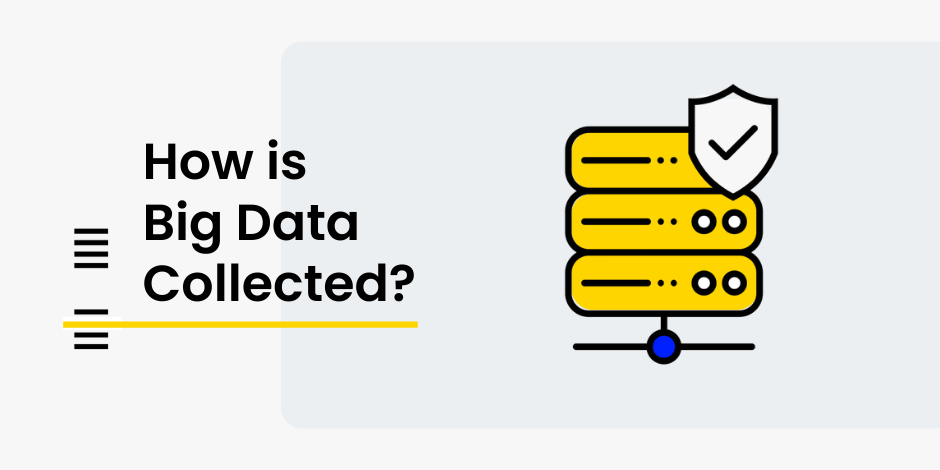How is Big Data Collected?

Stay Informed With Our Weekly Newsletter
Receive crucial updates on the ever-evolving landscape of technology and innovation.
In today’s digitally connected world, data is everywhere, and its volume continues to grow exponentially.
Big data refers to the vast amounts of structured, unstructured, and semi-structured data that are generated at an unprecedented rate.
Understanding how it is collected is crucial for organisations to harness the power of this valuable resource.
We delve into the concept, the process of its collection, the different types of big data, the tools and technologies involved, and the challenges that organisations face in collecting and managing it.
The concept of big data

Before we delve into the intricacies of big data collection, let’s first define what big data is.
The term refers to the enormous amount of information that is generated from various sources such as social media, sensors, logs, and other digital platforms.
This data is characterised by its volume, velocity, and variety, making it difficult to manage using traditional data processing methods.
But what exactly does it mean when we say big data?
To put it simply, it is like a vast ocean of information, constantly expanding and evolving. It is the digital footprint of our modern society, capturing every click, like, share, and transaction we make.
At least 70% of the world’s data is user-generated. It is the collective voice of millions, if not billions, of individuals, all contributing to this ever-growing pool of data.
Defining big data
Big data is typically described using the ‘3Vs’ model, which stands for volume, velocity, and variety.
Volume refers to the sheer amount of data generated, often in terabytes or petabytes.
Imagine a library filled with countless books, each containing countless pages of information. That’s the scale we’re talking about when it comes to big data.
Velocity represents the speed at which data is produced and needs to be processed in real-time or near real-time.
Think about the constant stream of tweets, posts, and messages being sent across social media platforms every second.
It’s like trying to catch a speeding bullet with a pair of chopsticks – a daunting task indeed.
Variety refers to the different formats and types of data, including text, images, videos, and more. It’s not just about the words we type or the numbers we crunch.
It’s about the images we capture, the videos we watch, and the voice recordings we make. It’s about the rich tapestry of multimedia that makes up our digital lives.
Its importance in today’s world
In today’s highly digitised world, big data plays a crucial role in driving innovation, improving decision-making, and gaining a competitive edge.
Organisations can leverage it to uncover valuable insights, identify trends, and make data-driven predictions. It’s like having a crystal ball that can peer into the future and guide us towards success.
Imagine a retail company analysing customer purchase patterns to optimise their inventory management.
By understanding what products are in high demand and when, they can ensure that their shelves are always stocked with the right items, minimising waste and maximising profits.
It’s a win-win situation for both the company and the customers.
Or consider a healthcare provider using data to improve patient outcomes.
By analysing vast amounts of medical records, genetic data, and real-time sensor readings, doctors can identify early warning signs of diseases, personalised treatment plans, and ultimately save lives. It’s a game-changer in the field of medicine.
From optimising supply chains to enhancing customer experiences, it has transformative potential across industries.
It’s not just about making better business decisions; it’s about making a positive impact on society as a whole.
The process of big data collection

Collecting data involves a systematic approach to identifying data sources and extracting relevant information. Let’s explore the key steps involved in this process.
Identifying data sources
The first step in collecting it is identifying the sources from which the data will be gathered. This can include social media platforms, customer databases, Internet of Things (IoT), devices, website logs, and more.
By understanding the available data sources, organisations can determine the scope of their data collection efforts.
Data extraction techniques
Once the data sources are identified, the next step is to extract the relevant information from these sources.
This can be achieved through various techniques, including web scraping, data mining, and data integration. Automation and artificial intelligence play a crucial role in efficiently extracting and organising large volumes of data.
Different types of big data
Big data can be classified into different categories based on its structure and format. Let’s explore the three main types.
Structured and unstructured data
Structured data refers to well-organised and easily searchable data that fits into predefined data models. This can include data stored in databases or spreadsheets.
Unstructured data, on the other hand, refers to information that does not have a specific format, making it difficult to organise and analyse without advanced tools.
Semi-structured data
Semi-structured data falls somewhere between structured and unstructured data. It has some organisational properties, but it also contains unformatted or inconsistent elements.
Examples of semi-structured data include emails, XML files, and social media posts.
Tools and technologies used in data collection

Effective data collection relies on a variety of tools and technologies that enable the extraction, storage, and analysis of large volumes of data. Let’s explore some of the key ones.
Overview of data collection tools
There are several data collection tools available that facilitate the gathering and organisation of data.
Some commonly used tools include Apache Hadoop, Elasticsearch, Apache Kafka, and Apache Spark.
These tools provide scalable and efficient ways to process and manage massive amounts of data.
Role of artificial intelligence in data collection
Artificial intelligence (AI) plays a vital role in data collection by automating repetitive tasks and improving data extraction accuracy.
AI-powered technologies, such as machine learning and natural language processing, enable organisations to uncover patterns, generate insights, and make predictions from large datasets.
Challenges in data collection
While big data offers immense potential, organisations also face several challenges when it comes to collecting and managing large volumes of data.
Data privacy and security concerns
One of the primary challenges is ensuring data privacy and security. With the increasing volume and variety of data, protecting sensitive information from unauthorised access and breaches is critical.
Organisations must implement robust security measures to safeguard data throughout the collection and storage process.
Managing data quality and consistency
Another significant challenge in the collection is maintaining data quality and consistency.
With such vast amounts of data being collected from multiple sources, ensuring accuracy, completeness, and consistency can be complex.
Data cleansing, validation, and integration techniques are essential to ensure the reliability of the collected data.
In conclusion
Understanding how big data is collected is essential for organisations to unlock its potential.
By comprehending the concept, identifying data sources, leveraging appropriate tools and technologies, and overcoming the associated challenges, organisations can harness the power of big data to drive innovation, improve decision-making, and gain a competitive advantage in today’s data-driven world.
Delve deeper into the world of data collection by taking one of our comprehensive programs at the Institute of Data.
If you have any questions about our programs or would like to discuss your options, feel free to schedule a complimentary consultation with our expert team.




